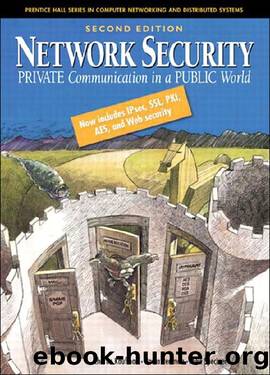Network Security by Speciner Mike & Radia Perlman & Mike Speciner

Author:Speciner, Mike & Radia Perlman & Mike Speciner [Speciner, Mike & Perlman, Radia & Speciner, Mike]
Language: eng
Format: epub
Publisher: Pearson Education
Published: 2002-08-14T23:00:00+00:00
14.10. Evading Password-Guessing Attacks
With Kerberos V4, there is no authentication of the request to the KDC for a TGT. Anyone can send a cleartext message to the KDC requesting a TGT for user [email protected], and the KDC will send back a ticket, encrypted according to Pope's master key. Since the function that maps a password string to a DES key is publicly known, an intruder can use the encrypted credentials for an off-line password-guessing attack to find Pope's password.
To avoid this attack, a mechanism has been added to Kerberos V5 in which information known as PREAUTHENTICATION-DATA can be sent along with the request for a TGT for user Pope which proves that the requester knew user Pope's master key. The preauthentication data consists of a current timestamp encrypted with user Pope's master key.
There's another opportunity for password guessing. Although the preauthentication data forces Alice to prove she knows user Pope's master key before she can obtain a TGT for Pope, she can use her own TGT or master key to ask for a ticket to the principal named Pope. She'll get back a quantity (the ticket to user Pope encrypted according to Pope's master key) which she can use for an off-line password-guessing attack to find Pope's password. Kerberos prevents this attack by marking database entries for human users (such as Pope), with a flag indicating that the KDC should not issue a ticket to this principal. This prevents someone from obtaining a ticket for something whose master key is derived from a password (and therefore vulnerable to password guessing). If, in the future, Kerberos is used for an application where it might make sense to create a ticket to a human user (for instance, electronic mail), then some other mechanism would need to be devised to prevent Alice from guessing passwords based on tickets she requests (see Homework Problem 5).
This does not avoid password-guessing attacks completely. Someone can still guess passwords by constructing a request to the KDC for each password guess, and eventually one will be accepted. If passwords are even moderately well chosen, however, this is likely to be a very time-consuming task. Furthermore, a KDC could include code to record the frequency of wrong password guesses and lock the target account and/or alert an administrator should a threshold be exceeded. A more important attack is that an eavesdropper who sees the initial Kerberos login exchange can perform an off-line password guessing attack using either the preauthentication data provided by the user or the TGT sent in response.
Download
This site does not store any files on its server. We only index and link to content provided by other sites. Please contact the content providers to delete copyright contents if any and email us, we'll remove relevant links or contents immediately.
Kotlin in Action by Dmitry Jemerov(17183)
Grails in Action by Glen Smith Peter Ledbrook(15390)
Sass and Compass in Action by Wynn Netherland Nathan Weizenbaum Chris Eppstein Brandon Mathis(13265)
Azure Containers Explained by Wesley Haakman & Richard Hooper(7499)
Configuring Windows Server Hybrid Advanced Services Exam Ref AZ-801 by Chris Gill(7496)
Running Windows Containers on AWS by Marcio Morales(7051)
Microsoft 365 Identity and Services Exam Guide MS-100 by Aaron Guilmette(5434)
Microsoft Cybersecurity Architect Exam Ref SC-100 by Dwayne Natwick(5272)
Combating Crime on the Dark Web by Nearchos Nearchou(5018)
The Ruby Workshop by Akshat Paul Peter Philips Dániel Szabó and Cheyne Wallace(4701)
Management Strategies for the Cloud Revolution: How Cloud Computing Is Transforming Business and Why You Can't Afford to Be Left Behind by Charles Babcock(4546)
Python for Security and Networking - Third Edition by José Manuel Ortega(4274)
The Age of Surveillance Capitalism by Shoshana Zuboff(4245)
Learn Wireshark by Lisa Bock(4175)
Learn Windows PowerShell in a Month of Lunches by Don Jones(4069)
The Ultimate Docker Container Book by Schenker Gabriel N.;(3919)
Ember.js in Action by Joachim Haagen Skeie(3661)
DevSecOps in Practice with VMware Tanzu by Parth Pandit & Robert Hardt(3609)
Windows Ransomware Detection and Protection by Marius Sandbu(3576)
